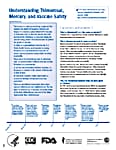Most vaccines currently available were developed using cell strains cultured from two fetuses
aborted for other purposes in the 1960s.
[3] This has led some to oppose vaccination on religious or moral grounds.
[1][2] However, vaccine experts and manufacturers state that vaccines do not contain any of the original fetal tissue or cells, that the abortions occurred decades ago and replenishment with new tissue has not occurred.
Source Wikipedia
Good question. I would like to know the answer to that question myself. Why can't they use a different strain of cells?
Great question and much of what I have heard seems to be confusion on the meaning of nanotechnology.
A good article on the subject and COVID vaccines can be found here. Dated July 15 2020
https://www.nature.com/articles/s41565-020-0737-y
Next-generation vaccines enabled through advances in nanotechnology
Viruses are nanoscale objects and therefore can be regarded as naturally occurring nanomaterials; per that definition, LAVs, IVs and viral vectors are nanotechnologies. Nanoparticles and viruses operate at the same length scale—this is what makes nanotechnology approaches in vaccine development and immunoengineering so powerful. Nanoparticles, natural or synthetic, mimic the structural features of viruses whereas chemical biology, biotechnology and nanochemistry enables the development of next-generation designer vaccine technologies. From a vaccine technology development point of view, this is an exciting time and novel technologies and approaches are poised to make a clinical impact for the first time.
Nucleic acid-based vaccines
Delivering the genetic code for in situ production of viral proteins is a promising alternative to conventional vaccine approaches. Both DNA and mRNA vaccines fall under this category and are being pursued in the context of the COVID-19 pandemic. While these platforms are attractive in terms of safety, speed, stability and scalability, they carry a significantly higher risk of failure in clinical development as seen previously with other novel technologies
40. To date there is no licensed DNA or RNA vaccine. Nevertheless, a particular advantage of these vaccines is that in addition to antibody and CD4+ T cell responses, DNA or RNA vaccine elicit CD8+ cytotoxic T cell responses, which plays a key role for virus eradication
41,
42. For the DNA vaccines, the frontrunner in this space is Inovio Pharmaceuticals with their Phase I clinical trial having commenced 6 April 2020. Another rising company on track for a Phase I clinical trial is Entos Pharmaceuticals, Inc. a company based in Alberta, Canada. mRNA vaccines can be produced through in vitro transcription, which precludes the need for cells and their associated regulatory hurdles
43. Moderna’s mRNA-based technology was the fastest to Phase I clinical trial in the US, which began on 16 March 2020 (see Table
1). Additionally, BioNTech-Pfizer recently announced regulatory approval in Germany for Phase I/II clinical trials to test four lead mRNA vaccine candidates
44.
While DNA vaccines offer higher stability over mRNA vaccines, the mRNA is non-integrating and therefore poses no risk of insertional mutagenesis. Additionally, the half-life, stability and immunogenicity of mRNA can be tuned through established modifications
45. For example, researchers at the Imperial College of London and Arcturus Therapeutics are incorporating self-amplifying RNA technology to prolong the otherwise short half-life of the RNA and thereby boost S protein expression levels
46 (
http://www.imperial.ac.uk/a-z-research/future-vaccine-hub/workstreams/rna-vaccine-manufacture). Nanotechnology-based approaches offer enabling solutions to the delivery challenge by trafficking the vaccine to appropriate cellular populations and subcellular locations. While synthetic nanocarriers including cationic liposomes and polymeric nanoparticles have been used for the delivery of DNA vaccines across cell membranes, targeted formulations could further enhance nuclear translocation of the plasmid DNA
47. Moderna’s mRNA vaccine is based on a lipid nanoparticle platform, but there are many other emerging nanotechnologies for delivery of nucleic acid vaccines (several structures are shown in Fig.
3). Nanotechnology platforms including cationic nanoemulsions, liposomes, dendrimers or polysaccharide particles have been employed for improving the stability and delivery of mRNA based vaccines
41,
45.
What's for lunch? I'm Starving!

1
1

